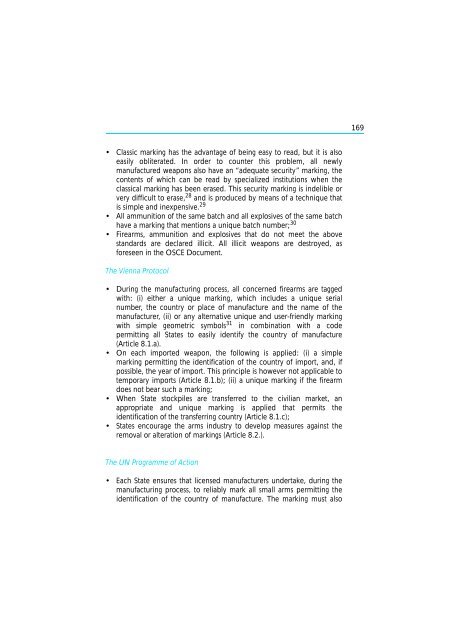The Scope and Implications of a Tracing Mechanism for Small Arms ...
The Scope and Implications of a Tracing Mechanism for Small Arms ...
The Scope and Implications of a Tracing Mechanism for Small Arms ...
You also want an ePaper? Increase the reach of your titles
YUMPU automatically turns print PDFs into web optimized ePapers that Google loves.
169<br />
• Classic marking has the advantage <strong>of</strong> being easy to read, but it is also<br />
easily obliterated. In order to counter this problem, all newly<br />
manufactured weapons also have an “adequate security” marking, the<br />
contents <strong>of</strong> which can be read by specialized institutions when the<br />
classical marking has been erased. This security marking is indelible or<br />
very difficult to erase, 28 <strong>and</strong> is produced by means <strong>of</strong> a technique that<br />
is simple <strong>and</strong> inexpensive. 29<br />
• All ammunition <strong>of</strong> the same batch <strong>and</strong> all explosives <strong>of</strong> the same batch<br />
have a marking that mentions a unique batch number; 30<br />
• Firearms, ammunition <strong>and</strong> explosives that do not meet the above<br />
st<strong>and</strong>ards are declared illicit. All illicit weapons are destroyed, as<br />
<strong>for</strong>eseen in the OSCE Document.<br />
<strong>The</strong> Vienna Protocol<br />
• During the manufacturing process, all concerned firearms are tagged<br />
with: (i) either a unique marking, which includes a unique serial<br />
number, the country or place <strong>of</strong> manufacture <strong>and</strong> the name <strong>of</strong> the<br />
manufacturer, (ii) or any alternative unique <strong>and</strong> user-friendly marking<br />
with simple geometric symbols 31 in combination with a code<br />
permitting all States to easily identify the country <strong>of</strong> manufacture<br />
(Article 8.1.a).<br />
• On each imported weapon, the following is applied: (i) a simple<br />
marking permitting the identification <strong>of</strong> the country <strong>of</strong> import, <strong>and</strong>, if<br />
possible, the year <strong>of</strong> import. This principle is however not applicable to<br />
temporary imports (Article 8.1.b); (ii) a unique marking if the firearm<br />
does not bear such a marking;<br />
• When State stockpiles are transferred to the civilian market, an<br />
appropriate <strong>and</strong> unique marking is applied that permits the<br />
identification <strong>of</strong> the transferring country (Article 8.1.c);<br />
• States encourage the arms industry to develop measures against the<br />
removal or alteration <strong>of</strong> markings (Article 8.2.).<br />
<strong>The</strong> UN Programme <strong>of</strong> Action<br />
• Each State ensures that licensed manufacturers undertake, during the<br />
manufacturing process, to reliably mark all small arms permitting the<br />
identification <strong>of</strong> the country <strong>of</strong> manufacture. <strong>The</strong> marking must also
















